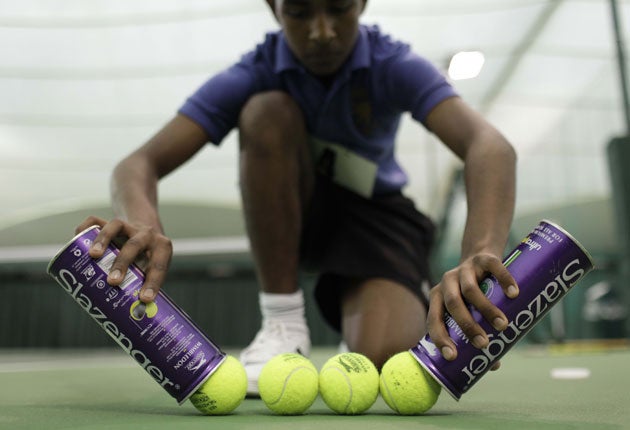Countdown to Wimbledon: Anyone for tennis balls?
The ball boys and girls at SW19 have to get it right. Kate Youde joins them as they go through their paces

Your support helps us to tell the story
From reproductive rights to climate change to Big Tech, The Independent is on the ground when the story is developing. Whether it's investigating the financials of Elon Musk's pro-Trump PAC or producing our latest documentary, 'The A Word', which shines a light on the American women fighting for reproductive rights, we know how important it is to parse out the facts from the messaging.
At such a critical moment in US history, we need reporters on the ground. Your donation allows us to keep sending journalists to speak to both sides of the story.
The Independent is trusted by Americans across the entire political spectrum. And unlike many other quality news outlets, we choose not to lock Americans out of our reporting and analysis with paywalls. We believe quality journalism should be available to everyone, paid for by those who can afford it.
Your support makes all the difference.Number 77 freezes at the middle of the net. "Who's just served, 77?" one of the tracksuited men and women armed with a clipboard bellows across the court, before hurrying across to advise his charge.
The nameless girl – identified only by the digits pinned to her front and back – is one of 50 silent recruits training to be part of the 250-strong army of ball boys and girls (BBGs) that will be on duty at Wimbledon.
Marshalling that army is Anne Rundle, whose benign appearance belies her sergeant-majorly role.
With eight days to go before the 125th Championships get under way, the teenagers – from 24 schools across south-west London and Surrey – are keen to toe the line, under the impression they could be axed from the squad at any time.
Following a kit check, No 77 and the others first endured a tiring warm-up regime of running on the spot and jumping. Now, they are engaged in a training exercise designed to simulate a real-life situation: they are practising moving the balls round the court during a tennis match. Former ball boys are purposely making errors, requesting towels, and forcing tie breaks to test their successors' skills. "Rain" suspends play.
The BBGs, whittled down from 700 applicants, will handle an astonishing 54,250 balls during the Grand Slam. And millions of television viewers across the globe will watch them do it.
"I am nervous I am going to make a big mistake," admits No 157, aka Cameron Monteith, 13, of Wallington County Grammar School. "Did you see the ball boy [at the French Open] who ran on to the court just as the player went to smash the ball and he ran straight into the player? I haven't done that yet."
The youngster says the BBGs must be on their toes constantly. "The trainers have to shout across courts to you but they are not shouting in your face," he adds. "They are quite nice, actually."
Indeed, Mrs Rundle, a grandmother of three, is a friendly, softly spoken lady. Now 65, this is likely to be her last tournament in charge. She is reluctant to retire from the "family". "It's a club rule," sighs Mrs Rundle. "The law changed a bit too late for me." She started helping out with the BBG training part time in 1969 when she was a maths teacher in Merton.
There have been many changes over the years: ball girls were introduced in 1977, with the first mixed BBG teams in 1980. But it was not until 1985 that the All England Club allowed ball girls to oversee matches on Centre Court. The ratio of ball girls to boys is now about 50/50. Mrs Rundle selects four teams of six to be responsible for Centre and No 1 courts, with six teams rotating around the other show courts. The remaining BBGs work on the rest of the courts.
The beady-eyed adults patrolling the practice are marking the children's feeding and ball rolling. Among them is Claire Strugnell, 28, assistant headteacher at Avenue Primary School in Sutton, who was a ball girl in 1998 and 1999 and now helps to train the teenagers.
She became the oldest ball girl at Wimbledon when, as a 22-year-old BBG supervisor, organisers opened up a court at short notice and she had to help out. "I still had false acrylic nails on from my university ball, which didn't help rolling the balls but it was good fun," she recalls.
The teenagers training today are from a range of backgrounds and schools. "These days, they are really nice children that come and do it," says Mrs Rundle. "When I first did it, it was more like reform school."
No 152, aka 15-year-old Helena Popovic, of Holy Cross school in New Malden, a Catholic state girls' school, has been training since October. "I am really scared but I have been watching the French Open and Queen's," she says. "Their ball girls and boys are really messy compared with us. "
Mrs Rundle adds: "I think in the French, the ball boys and girls are part of the razzmatazz, and in your face a bit, whereas at Wimbledon we are more in the background."
They are an important part of the tournament's history, nonetheless. Adrian Bailey, 16, who, with twin brother, Thomas, ball-boyed for Wimbledon's longest match – between John Isner and Nicolas Mahut last year – says: "The balls in the museum [from that match] we have actually touched!"
Join our commenting forum
Join thought-provoking conversations, follow other Independent readers and see their replies
Comments